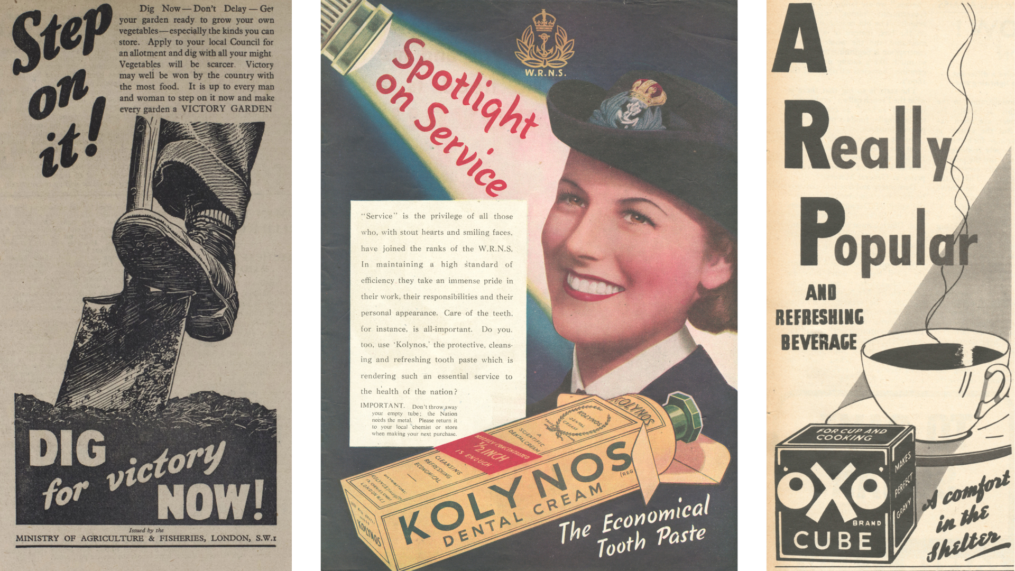Already a member? Sign in below

As we remember the D-Day landings which started the liberation of Europe on 6 June 1944, eighty years ago, what was happening on the Home Front? Within a year, on 14 June 1945, Advertiser’s Weekly asserted that advertising had “helped to win the war”. Did it really?
This tribute would have seemed optimistic in the early years of the conflict. In September 1939 with economic and political uncertainty gripping the nation, advertising spend halved compared to the same month in 1938. Over the next two years, the Government introduced new and restrictive controls on trade and prices. It seriously considered censorship restrictions for both editorial and for advertising. Pooling arrangements for staple commodities such as margarine, soft drinks and other basic consumer goods threatened the very existence of brands. Without brands, advertising seemed pointless.
After the war, the Advertising Association’s Journal said that 1942 had proved “the most difficult moment in its history”. The turning point in the war hadn’t yet come, problems on the Home Front, including the paper shortage which severely limited advertising space in the newspapers, were acute. The mere existence of commercial advertising was a subject of bitter criticism in Parliament and elsewhere. It was widely feared that the advertising industry would never recover.
Yet behind the scenes, the Advertising Association was at work. Its President, Lord Ashfield, along with a committee representing the publishers, advertisers and agencies, was busily persuading Ministers that commercial advertising was important to the country’s economy and trade – that it was “the vital element upon which its future rests”. The committee also demonstrated that it was the advertising revenues that kept the national and local press alive, enabling them to provide the Nation with news and information that the classified advertisements in the local press helped bind local communities together, through their births, marriages and deaths announcements.
Brands often used their advertising to promote messages that were patriotic and supported the war effort, for example, the advertisement in 1943 for Kolynos dental cream entitled “Spotlight on Service”. This praised the service of those who had joined the WRNS “with stout hearts and smiling faces”. It went on to say that they “take an immense pride in their work, their responsibilities and their personal appearance. Care of the teeth, for instance, is all-important”. Of course, this was all down to Kolynos dental cream which was “rendering such an essential service to the health of the nation”.
In numerous ads of the period, we see brands emphasising the need to be thrifty and to re-cycle things in the face of rationing and shortages. An important footnote on the Kolynos dental cream advertisement says: “don’t throw away your empty tube: the Nation needs the metal. Please return it to your local chemist or store when making your next purchase”.
Manufacturers in the War were often promoting goods that were in short supply and having to manage public expectations whilst keeping the brand in people’s consciousness. Bikes were a useful means of transport at a time of petrol shortages, but not always immediately available as the troops had priority over private citizens. A bike ad aimed at boys in Picture Post in 1944 said “Of course you’d like a BSA too – but you may have to wait a while”. “Smith has had his BSA for ages and it’s still the newest-looking bicycle in the school”.
Of course the Ministry of Information (MOI) became the biggest advertiser of all during the war. The Government used advertising very widely to communicate essential information and tips as to how to support the war effort. Some of those wartime slogans, like Dig for Victory!, Careless Talk Costs Lives are still very well known today.
So was Advertiser’s Weekly” justified in saying that advertising had “helped to win the war”? Difficult though it is to single out just one factor in victory, no one could reasonably doubt that advertising, in spite of all the difficulties, did its bit to make people feel they were all “in it” together and to lift the public spirit. And that, surely, was a big helping hand.
With thanks to the History of Advertising Trust and to David Clampin whose book: “Advertising and Propaganda in World War II” has inspired the content of this article.
Already a member? Sign in below
If your company is already a member, register your email address now to be able to access our exclusive member-only content.
If your company would like to become a member, please visit our Front Foot page for more details.
Enter your email address to receive a link to reset your password
Your password needs to be at least seven characters. Mixing upper and lower case, numbers and symbols like ! " ? $ % ^ & ) will make it stronger.
If your company is already a member, register your account now to be able to access our exclusive member-only content.